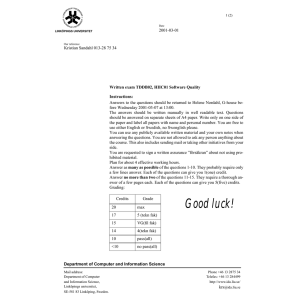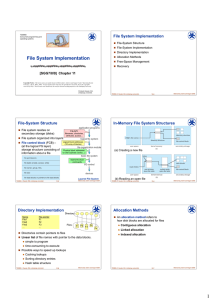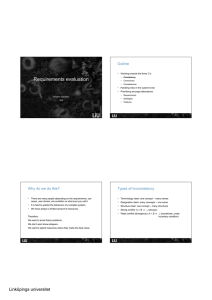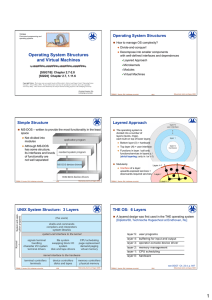Agenda Introduction
advertisement
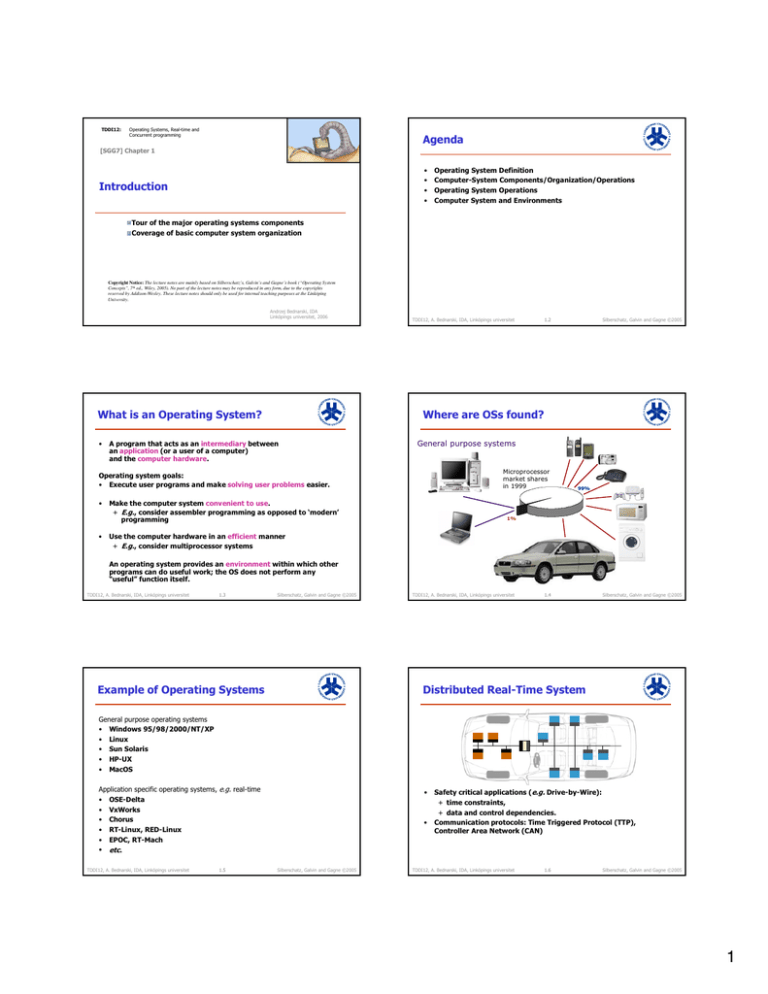
TDDI12: Operating Systems, Real-time and Concurrent programming Agenda [SGG7] Chapter 1 • • • • Introduction Operating System Definition Computer-System Components/Organization/Operations Operating System Operations Computer System and Environments Tour of the major operating systems components Coverage of basic computer system organization Copyright Notice: The lecture notes are mainly based on Silberschatz’s, Galvin’s and Gagne’s book (“Operating System Concepts”, 7th ed., Wiley, 2005). No part of the lecture notes may be reproduced in any form, due to the copyrights reserved by Addison-Wesley. These lecture notes should only be used for internal teaching purposes at the Linköping University. Andrzej Bednarski, IDA Linköpings universitet, 2006 What is an Operating System? • TDDI12, A. Bednarski, IDA, Linköpings universitet • Silberschatz, Galvin and Gagne ©2005 Where are OSs found? A program that acts as an intermediary between an application (or a user of a computer) and the computer hardware. General purpose systems Microprocessor market shares in 1999 Operating system goals: • Execute user programs and make solving user problems easier. • 1.2 Make the computer system convenient to use. + E.g., consider assembler programming as opposed to ‘modern’ programming 99% 1% Use the computer hardware in an efficient manner + E.g., consider multiprocessor systems An operating system provides an environment within which other programs can do useful work; the OS does not perform any “useful” function itself. TDDI12, A. Bednarski, IDA, Linköpings universitet 1.3 Silberschatz, Galvin and Gagne ©2005 Example of Operating Systems TDDI12, A. Bednarski, IDA, Linköpings universitet 1.4 Silberschatz, Galvin and Gagne ©2005 Distributed Real-Time System General purpose operating systems • Windows 95/98/2000/NT/XP • Linux • Sun Solaris • HP-UX • MacOS Application specific operating systems, e.g. real-time • OSE-Delta • VxWorks • Chorus • RT-Linux, RED-Linux • EPOC, RT-Mach • etc. TDDI12, A. Bednarski, IDA, Linköpings universitet 1.5 • • Silberschatz, Galvin and Gagne ©2005 Safety critical applications (e.g. Drive-by-Wire): + time constraints, + data and control dependencies. Communication protocols: Time Triggered Protocol (TTP), Controller Area Network (CAN) TDDI12, A. Bednarski, IDA, Linköpings universitet 1.6 Silberschatz, Galvin and Gagne ©2005 1 Computer System Components Operating System Definition 1. Hardware – provides basic • computing resources (CPU, memory, I/O devices). 2. Operating system – controls and coordinates the use of the hardware among the various application programs for the various users. • • • 3. Applications programs – define the ways in which the system resources are used to solve the computing problems of the users (compilers, database systems, games, …). • 4. Users (people, machines, other computers). TDDI12, A. Bednarski, IDA, Linköpings universitet 1.7 Silberschatz, Galvin and Gagne ©2005 Computer-System Organization TDDI12, A. Bednarski, IDA, Linköpings universitet I/O devices and the CPU can execute concurrently. Each device controller is in charge of a particular device type. Each device controller has a local buffer. CPU moves data from/to main memory to/from local buffers I/O is from the device to local buffer of controller. Device controller informs CPU that it has finished its operation by causing an interrupt. 1.9 Silberschatz, Galvin and Gagne ©2005 TDDI12, A. Bednarski, IDA, Linköpings universitet Common Functions of Interrupts Interrupt Handling • • • • • Silberschatz, Galvin and Gagne ©2005 Computer-system operation + One or more CPUs, device controllers connect through common bus providing access to shared memory + Concurrent execution of CPUs and devices competing for memory cycles TDDI12, A. Bednarski, IDA, Linköpings universitet • 1.8 Computer-System Operation • • • • • • • OS is a resource allocator + Manages all computer resources + Decides between conflicting requests for efficient and fair resource use OS is a control program + Controls execution of programs to prevent errors and improper use of the computer No universally accepted definition “Everything a vendor ships when you order an operating system” is good approximation + But varies wildly “The one program running at all times on the computer” is called the kernel. Everything else is either a system program (ships with the operating system) or an application program. Interrupt transfers control to the interrupt service routine generally, through the interrupt vector, which contains the addresses of all the service routines. Interrupt architecture must save the address of the interrupted instruction. Incoming interrupts are disabled while another interrupt is being processed to prevent a lost interrupt. A trap is a software-generated interrupt caused either by an error or a user request. An operating system is interrupt driven. TDDI12, A. Bednarski, IDA, Linköpings universitet 1.11 Silberschatz, Galvin and Gagne ©2005 • • 1.10 Silberschatz, Galvin and Gagne ©2005 The operating system preserves the state of the CPU by storing registers and the program counter. Determines which type of interrupt has occurred: + polling + vectored interrupt system Separate segments of code determine what action should be taken for each type of interrupt TDDI12, A. Bednarski, IDA, Linköpings universitet 1.12 Silberschatz, Galvin and Gagne ©2005 2 Interrupt Timeline I/O Structure: Synchronous • • Example of a single process doing output After I/O starts, control returns to user program only upon I/O completion. + wait instruction idles the CPU until the next interrupt + wait loop (tight loop: Loop: jmp Loop) continues until the interrupt + At most one I/O request is outstanding at a time, no simultaneous I/O processing, that is, you know the device. Disadvantages: • Burns CPU cycles • Excludes concurrent I/O operations to multiple devices • Excludes overlapping useful computation with I/O TDDI12, A. Bednarski, IDA, Linköpings universitet 1.13 Silberschatz, Galvin and Gagne ©2005 I/O Structure: Asynchronous • TDDI12, A. Bednarski, IDA, Linköpings universitet 1.14 Silberschatz, Galvin and Gagne ©2005 Two I/O Methods After I/O starts, the CPU does not wait for I/O completion, instead other OS and user programs are executed + control is returned to the user program before I/O completion + System call – request to the operating system to allow user to wait for I/O completion. + Device-status table contains entry for each I/O device indicating its type, address, and state. + Operating system indexes into I/O device table to determine device status and to modify table entry to include interrupt. Synchronous Asynchronous Advantage: + Efficient usage of the CPU resource TDDI12, A. Bednarski, IDA, Linköpings universitet 1.15 Silberschatz, Galvin and Gagne ©2005 Direct Memory Access (DMA) Structure • Used for high-speed I/O devices able to transmit information at close to memory speeds. • Device controller transfers blocks of data from buffer storage directly to main memory without CPU intervention. • Only one interrupt is generated per block, rather than the one interrupt per byte. • DMA “steals” memory cycles from the CPU, which might slow down the processor while a DMA transfer is in progress. TDDI12, A. Bednarski, IDA, Linköpings universitet 1.17 Silberschatz, Galvin and Gagne ©2005 TDDI12, A. Bednarski, IDA, Linköpings universitet 1.16 Silberschatz, Galvin and Gagne ©2005 Modern Computer System TDDI12, A. Bednarski, IDA, Linköpings universitet 1.18 Silberschatz, Galvin and Gagne ©2005 3 Storage Hierarchy • Storage systems organized in hierarchy. + Speed + Cost + Volatility • Caching – copying information into faster storage system; main memory can be viewed as a last cache for secondary storage. TDDI12, A. Bednarski, IDA, Linköpings universitet Performance of Various Levels of Storage 1.19 Silberschatz, Galvin and Gagne ©2005 TDDI12, A. Bednarski, IDA, Linköpings universitet 1.20 Silberschatz, Galvin and Gagne ©2005 Caching Memory Consistency Problems • • Multitasking environments must be careful to use most recent value, not matter where it is stored in the storage hierarchy • Multiprocessor environment must provide cache coherency in hardware such that all CPUs have the most recent value in their cache Distributed environment situation even more complex + Several copies of a datum can exist + Various solutions covered in Chapter 17 • • • Important principle, performed at many levels in a computer (in hardware, operating system, software) Information in use copied from slower to faster storage temporarily Faster storage (cache) checked first to determine if information is there + If it is, information used directly from the cache (fast) + If not, data copied to cache and used there Cache smaller than storage being cached + Cache management important design problem + Cache size and replacement policy TDDI12, A. Bednarski, IDA, Linköpings universitet 1.21 Silberschatz, Galvin and Gagne ©2005 • TDDI12, A. Bednarski, IDA, Linköpings universitet 1.22 Silberschatz, Galvin and Gagne ©2005 Operating System Operations Hardware Protection: Dual Mode Operation • • • • • • Hardware protection: Dual mode CPU management + Uniprogramming + Multiprogramming + Multitasking Memory management File system and mass storage management Protection and security TDDI12, A. Bednarski, IDA, Linköpings universitet 1.23 Sharing system resources requires the operating system to ensure that an incorrect program cannot cause other programs to execute incorrectly. Provide hardware support to differentiate between at least two modes of operations. 1. 2. Silberschatz, Galvin and Gagne ©2005 User mode – execution done on behalf of a user. Monitor mode (also supervisor mode or system mode) – execution done on behalf of operating system. Executes only privileged instructions (instructions that may be harmful, e.g., system login, set priorities, system halt, etc.) TDDI12, A. Bednarski, IDA, Linköpings universitet 1.24 Silberschatz, Galvin and Gagne ©2005 4 Dual Mode: Example of System Call • • • Uniprogramming Mode bit added to computer hardware to indicate the current mode: monitor (0) or user (1). When an interrupt or fault occurs hardware switches to monitor mode. Privileged instructions can be issued only in monitor mode. Running 0 Running Waiting 10 110 Waiting 120 220 Process execution time: CPU: 10 + 10 time units I/O: 100 + 100 time units I.e., I/O intensive (200/220 = 90.9%), CPU utilization 9.1% TDDI12, A. Bednarski, IDA, Linköpings universitet 1.25 Silberschatz, Galvin and Gagne ©2005 TDDI12, A. Bednarski, IDA, Linköpings universitet Multiprogramming • 1.26 Silberschatz, Galvin and Gagne ©2005 Multiprogramming with three programs Needed for efficiency + Single user cannot keep CPU and I/O devices busy at all times + Multiprogramming organizes jobs (code and data) so CPU always has one to execute + A subset of total jobs in system is kept in memory + One job selected and run via job scheduling + When it has to wait (for I/O for example), OS switches to another job A Running B Waiting (printer) Running C Running Waiting Running Waiting (disk) Running Waiting (network) Waiting Running Waiting Running Running Running Waiting Running Running Running Waiting combined TDDI12, A. Bednarski, IDA, Linköpings universitet 1.27 Silberschatz, Galvin and Gagne ©2005 TDDI12, A. Bednarski, IDA, Linköpings universitet 1.28 Timesharing/Multitasking Timer Interrupt in Multitasking • • CPU switches jobs so frequently that users can interact with each job while it is running, creating interactive computing + Response time should be < 1 second + Each user has at least one program executing in memory > process + If several jobs ready to run at the same time > CPU scheduling + If processes do not fit in memory, swapping moves them in and out to run + Virtual memory allows execution of processes not completely in memory TDDI12, A. Bednarski, IDA, Linköpings universitet 1.29 Silberschatz, Galvin and Gagne ©2005 Silberschatz, Galvin and Gagne ©2005 Prevents infinite loop / process hogging resources + Set interrupt after specific period + Operating system decrements counter + When counter reaches zero, it generates an interrupt + Set up before scheduling process to regain control or terminate program that exceeds allocated time TDDI12, A. Bednarski, IDA, Linköpings universitet 1.30 Silberschatz, Galvin and Gagne ©2005 5 Multitasking: Time-sharing the CPU Pgm. 1 executing waiting Process Management executing … waiting … • • executing Pgm. 2 OS dispatcher program • • waiting waiting waiting … quantum clock interrupt TDDI12, A. Bednarski, IDA, Linköpings universitet clock interrupt 1.31 clock interrupt Silberschatz, Galvin and Gagne ©2005 Process Management Activities TDDI12, A. Bednarski, IDA, Linköpings universitet Creating and deleting both user and system processes Suspending and resuming processes Providing mechanisms for process synchronization Providing mechanisms for process communication Providing mechanisms for deadlock handling • • • TDDI12, A. Bednarski, IDA, Linköpings universitet 1.33 1.32 Silberschatz, Galvin and Gagne ©2005 Memory: A large array of words or bytes, each with its own address + Primary storage – directly accessible from CPU + Shared by CPU and I/O devices + A volatile medium + All data in memory before and after processing + All instructions in memory in order to execute Memory management determines what is in memory when + Optimizing CPU utilization and computer response to users OS memory management activities + Keeping track of which parts of memory are currently being used and by whom + Deciding which processes (or parts thereof) and data to move into and out of memory + Allocating and deallocating memory space as needed TDDI12, A. Bednarski, IDA, Linköpings universitet 1.34 Mass-Storage Management (1) Mass-Storage Management (2) • • • • • Disks used to store data that does not fit in main memory or data that must be kept for a “long” period of time. + Secondary storage OS activities: + Free-space management + Storage allocation + Disk scheduling Critical for system performance Some storage need not be fast + Tertiary storage optical storage, magnetic tape + Still must be managed TDDI12, A. Bednarski, IDA, Linköpings universitet • 1.35 Silberschatz, Galvin and Gagne ©2005 Memory Management The operating system is responsible for the following activities in connection with process management: • • • • • • • A process is a program in execution + Unit of work within the system + Program is a passive entity, process is an active entity Process needs resources to accomplish its task + CPU, memory, I/O, files, etc. + Initialization data Process termination requires reclaim of any reusable resources Single-threaded process has one program counter specifying location of next instruction to execute + Process executes instructions sequentially, one at a time, until completion Multi-threaded process has one program counter per thread Typically system has many processes (user, OS running concurrently on one or more CPUs). + Concurrency by multiplexing the CPUs among the processes / threads Silberschatz, Galvin and Gagne ©2005 Silberschatz, Galvin and Gagne ©2005 OS provides uniform, logical view of information storage + Abstracts physical properties to logical storage unit – file + Each medium is controlled by device (i.e., disk drive, tape drive) ̶ Varying properties include access speed, capacity, datatransfer rate, access method (sequential or random) File-System management + Files usually organized into directories + Access control on most systems to determine who can access what + OS activities include ̶ Creating and deleting files and directories ̶ Primitives to manipulate files and directories ̶ Mapping files onto secondary storage ̶ Backup files onto stable (non-volatile) storage media TDDI12, A. Bednarski, IDA, Linköpings universitet 1.36 Silberschatz, Galvin and Gagne ©2005 6 Protection and Security Computer Systems and Environments • • • • • Protection – any mechanism for controlling access of processes or users to resources defined by the OS Security – defense of the system against internal and external attacks + Huge range, including denial-of-service, worms, viruses, identity theft, theft of service Systems generally first distinguish among users, to determine who can do what + User identities (user IDs, security IDs) include name and associated number, one per user + User ID then associated with all files, processes of that user to determine access control + Group identifier (group IDs) allows set of users to be defined and controls managed, then also associated with each process, file + Privilege escalation allows user to change to effective ID with more rights TDDI12, A. Bednarski, IDA, Linköpings universitet 1.37 Silberschatz, Galvin and Gagne ©2005 • • • • • Stand-alone desktop computer Distributed systems + Client-server systems + Peer-to-peer computing systems Parallel Systems (TDDC78 – Programming Parallel Computers) Real-time systems Handheld systems Embedded systems Web based computing TDDI12, A. Bednarski, IDA, Linköpings universitet 1.38 Stand-alone Desktop Computer Client-Server Computing • • • • • Blurring over time Office environment + PCs connected to a network, terminals attached to mainframe or minicomputers providing batch and timesharing + Now portals allowing networked and remote systems access to same resources Home networks + Used to be single system, then modems + Now firewalled, networked TDDI12, A. Bednarski, IDA, Linköpings universitet 1.39 Silberschatz, Galvin and Gagne ©2005 • Silberschatz, Galvin and Gagne ©2005 Servers respond to requests generated by clients Compute server: provides an interface to client to request services (i.e. database) File server: provides am interface for clients to store and retrieve files TDDI12, A. Bednarski, IDA, Linköpings universitet 1.40 Silberschatz, Galvin and Gagne ©2005 Peer-to-peer Computing Real-Time Systems • • Often used as a control device in a dedicated application such as controlling scientific experiments, medical imaging systems, industrial control systems, and some display systems. • Well-defined and fixed time constraints. • Hard real-time system + Secondary storage limited or absent data stored in short-term memory, or read-only memory (ROM) + Conflicts with time-sharing systems, not supported by general-purpose RT-OS Soft real-time system + Limited utility in industrial control or robotics + Useful in applications (multimedia, virtual reality) requiring advanced operating system features. P2P does not distinguish clients and servers + Instead all nodes are considered peers + Each node may act as client, server or both + Node must join P2P network ̶ Registers its service with central lookup service on network, or ̶ Broadcast request for service and respond to requests for service via discovery protocol (e.g. Napster and Gnutella) TDDI12, A. Bednarski, IDA, Linköpings universitet 1.41 Silberschatz, Galvin and Gagne ©2005 • TDDI12, A. Bednarski, IDA, Linköpings universitet 1.42 Silberschatz, Galvin and Gagne ©2005 7 Recommended Reading and Exercises • Reading + [SGG7] Chapter 1 • Exercises + All TDDI12, A. Bednarski, IDA, Linköpings universitet 1.43 Silberschatz, Galvin and Gagne ©2005 8
